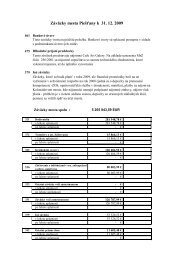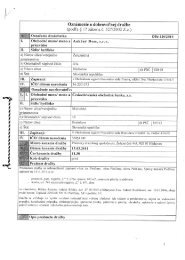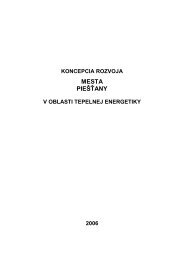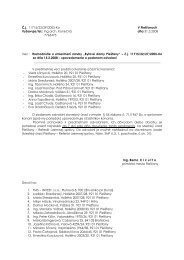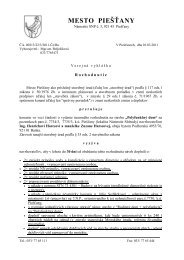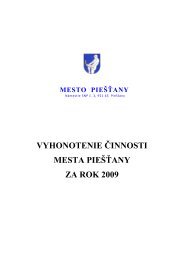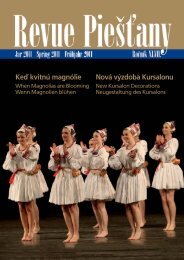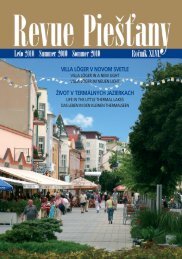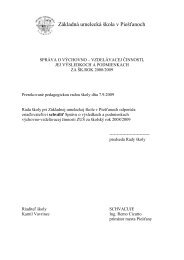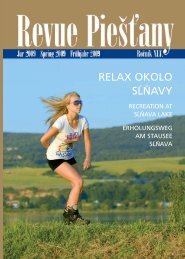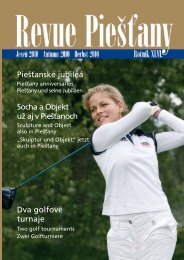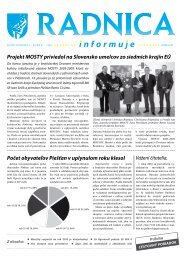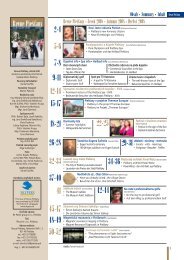LETO 2009 - Piešťany
LETO 2009 - Piešťany
LETO 2009 - Piešťany
Sie wollen auch ein ePaper? Erhöhen Sie die Reichweite Ihrer Titel.
YUMPU macht aus Druck-PDFs automatisch weboptimierte ePaper, die Google liebt.
village of Banka in 1902. The cache of<br />
artefacts had found its way to Vienna,<br />
Austria, where it appeared in an<br />
antique shop between 1924 and 1929.<br />
Imrich Winter regained it for the <strong>Piešťany</strong><br />
Museum with the help of Austrian<br />
archeologist E. Beninger. Also thanks to<br />
Winter, the <strong>Piešťany</strong> Museum Society and the<br />
local museum managed to retrieve the finds<br />
from a Migration Period burial site in<br />
Krakovany-Stráže; and paleontological finds -<br />
bones, teeth and mammoth tusks - from<br />
a brickyard in Trebatice. The <strong>Piešťany</strong> Museum<br />
Society carried out several archeological<br />
surveys in the surroundings of <strong>Piešťany</strong> with<br />
the cooperation of Czech archeologist Jiří<br />
Neustupný. From 1933 - 1939, along with<br />
Václav Vlk and Ernest Opluštil, he saved a few<br />
artefacts from the rich graves of counts from<br />
the Roman Period in Krakovany-Stráže.<br />
One of the foundations of the museum is<br />
a minor collection of items from Carnuntum,<br />
a Roman military camp and civil town near<br />
Petronell in Lower Austria. These finds were<br />
the result of Imrich Winter’s archeological<br />
and collecting activities; he probably bought<br />
the items from a Viennese antique dealer in<br />
the 1930s. The military camp was built on top<br />
of an original Celtic settlement at the<br />
crossroads of the Danubian and Amber ways.<br />
It was an important part of Limes Romanus -<br />
a fortified border of the Roman Empire on<br />
the Danube - and headquarters for the<br />
troops of the 15th legion, which finally<br />
abandoned it around 114 A.D. It was then<br />
taken over by the 14th legion, which<br />
probably stayed there until the end of Roman<br />
dominance at the close of the 4th century<br />
A.D. There were many significant buildings<br />
there - amphitheatres, a forum, spa buildings,<br />
a governor's residence, a temple, and<br />
shopping and residential quarters.<br />
Carnuntum has been researched by<br />
archeologists since the second half of the<br />
19th century; artefacts from the area<br />
s Rímska hlinená lampička zdobená plastickou výzdobou.<br />
A Roman clay lamp with plastic decoration.<br />
Römisches Tonlämpchen, verziert mit plastischen Motiven<br />
in the museum collection date back to the<br />
2nd - 3rd century A.D.(primarily the statues),<br />
and to the 3rd - 4th century A.D., the period<br />
of the town's development and eventual<br />
decline. The collection consists of Roman<br />
metal and ceramic items such as bronze hair<br />
accessories, pendants, earrings, beads, and<br />
toiletries such as mirrors and tweezers. Two<br />
tiny bronze statues are the most beautiful of<br />
the metal items - a figure of Minerva and<br />
a warrior. The statue of Minerva (known by<br />
the Greeks as Athena, for the Romans she<br />
was the patron goddess of warriors, medicine<br />
and crafts, among other things) wears a palla<br />
(a shawl-like mantle draped over the<br />
shoulders and fastened with a brooch) and<br />
stola (floor-length, sleeveless strapped dress)<br />
and has a Corinthian helmet with a partlypreserved<br />
crest of feathers on her head. The<br />
statue of the male warrior carries a round<br />
shield-like object in his right hand, and<br />
originally had a spear in his left hand.<br />
The collection also features a unique bronze<br />
sword with a blade decorated with a simple<br />
geometric pattern. There is also a group of<br />
small ceramic items which consists of various<br />
t Drobná miska s dvoma horizontálnymi uškami.<br />
A small bowl with two horizontal handles.<br />
Kleine Schale mit zwei horizontalen Henkeln<br />
types of simple amphoras (small vases<br />
with long, narrow necks and handles<br />
on either side); a kettle painted with<br />
wavy lines and dark red horizontal<br />
stripes; and clay burners. There are also<br />
fragments of statues made of terra cotta:<br />
a head of a woman and a man wearing<br />
a hooded cloak.<br />
You can see Imrich Winter’s collection of<br />
Roman artifacts from Carnuntum in the<br />
permanent exhibition of the Balneological<br />
Museum in Kúpeľná Dvorana (Spa Hall). z<br />
I<br />
mrich Winter interessierte sich für Kultur,<br />
Geschichte und Kunst (Musik, Literatur,<br />
Theater) seine besondere<br />
Aufmerksamkeit jedoch galt der Archäologie<br />
- vor allem im Zusammenhang mit der Region<br />
<strong>Piešťany</strong>. Er trug zur Rettung mehrerer<br />
bedeutender archäologischer Funde bei und<br />
schuf zusammen mit Václav Vlk das<br />
Fundament der heutigen archäologischen<br />
Sammlung des Museums. Vielleicht war es -<br />
aus heutiger Sicht - kein quantitativ<br />
umfangreicher Sammlungsbestand, dafür ein<br />
qualitativ sehr wertvoller.<br />
Imrich gelang es unter anderem „einen<br />
Schatz“ aus Bronzegegenständen, entdeckt<br />
1902 bei der Gewinnung von Lehm in der<br />
Ziegelbrennerei „Weisz-Prokeš“ in der<br />
Ortschaft Banka, für das Museum<br />
aufzuspüren. Der gefundene Schatz gelang<br />
nämlich nach Österreich und wurde erst<br />
zwischen den Jahren 1924 - 1929 in einer<br />
Antiquitätenhandlung in Wien entdeckt.<br />
Imrich Winter konnte ihn mit Hilfe des<br />
österreichischen Archäologen E. Beninger für<br />
das Museum von <strong>Piešťany</strong> zurückgewinnen.<br />
Dank Imrich Winter konnten für die<br />
Museumsgesellschaft von <strong>Piešťany</strong> und das<br />
hiesige Museum ebenfalls Artefakte aus<br />
einem Gräberfeld aus der Völkerwanderungszeit<br />
in Krakovany-Stráže<br />
41



